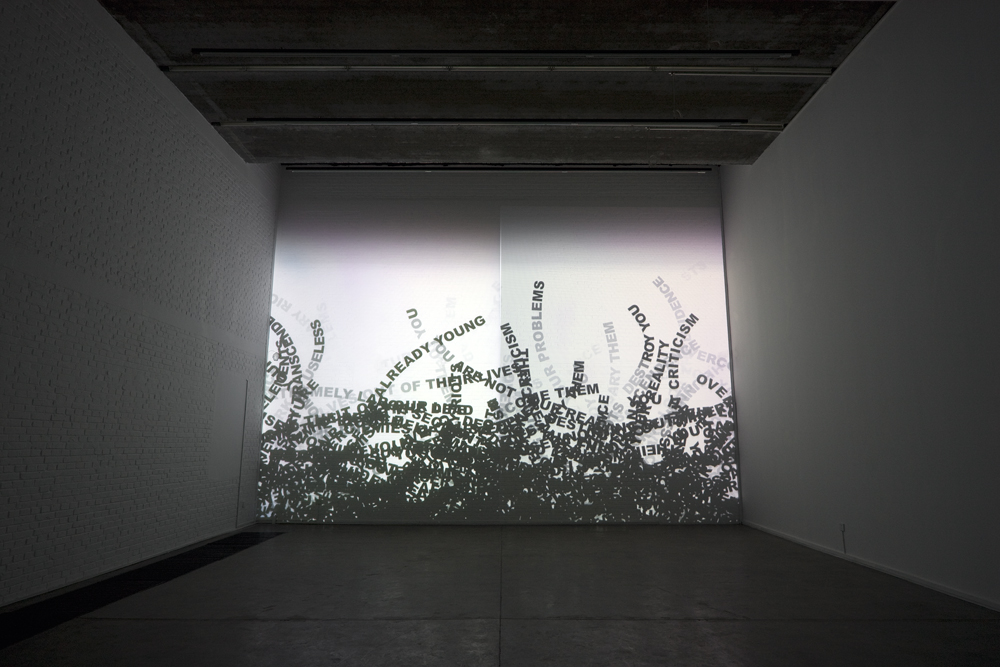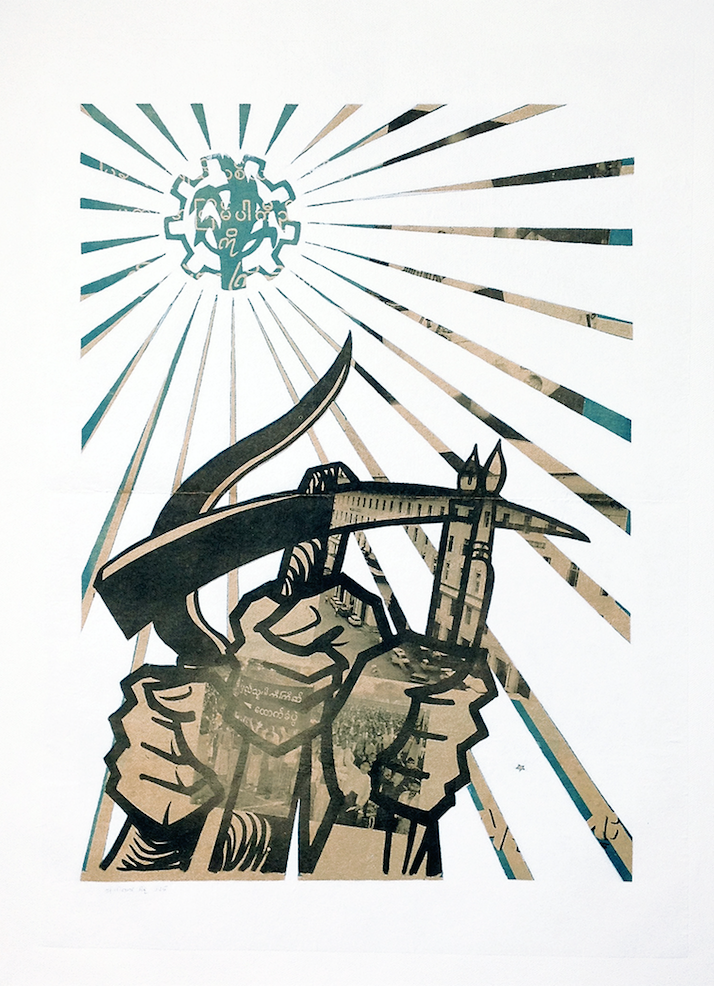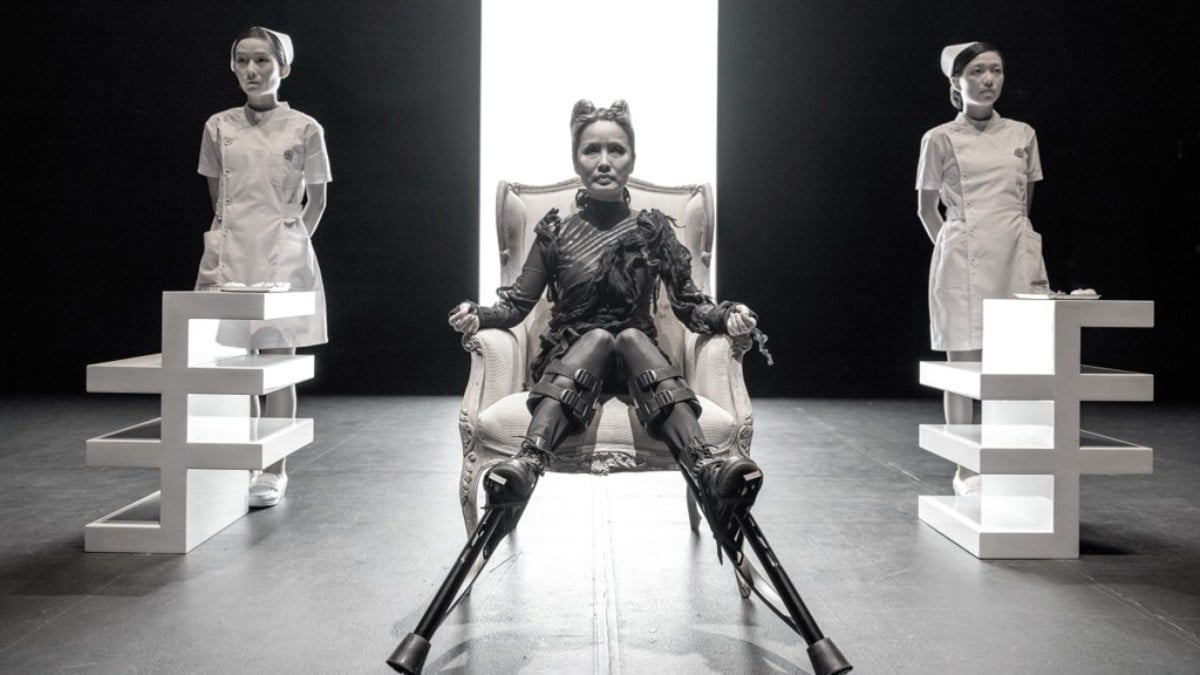
© » KADIST
Christine Sun Kim
Hand Palm Echo 1 is a digital animation based on Christine Sun Kim’s staircase mural at The Drawing Center in New York (10 March – 22 May, 2022). Sun produced this NFT from a still image of the animation that features a drawn notation of the sign “echo” in American Sign Language. Visually the black and white image depicts two side by side mounds, one labelled ‘Hand’ and the other labelled ‘Palm’.

© » KADIST
Christine Sun Kim and Thomas Mader
Indexes that either allow or inhibit the establishment of communication exist in both signed as well as spoken languages. Some differ radically depending on a variety of social, economic and geographical factors, while others are universally understood. Seemingly small and fleeting gestures can determine a sense of affiliation or a feeling of rejection.

© » KADIST
Hun Kyu Kim
Readymade Flea Market is part of a series of works developed by Hun Kyu Kim. While the artist’s previous work drew a parallel between capitalism’s inherent social violence and the evolution of weaponry, Hun Kyu Kim now focuses on political nihilism and how to overcome it. In this new work he uses the metaphor of 3D Graphic Space to represent our current reality.

© » KADIST
Sung Hwan Kim
An early work in Sung Hwang Kim’s career, the video Summer Days in Keijo—written in 1937 is a fictional documentary, the film is based on a non-fiction travelogue, In Korean Wilds and Villages , written by Swedish zoologist Sten Bergman, who lived in Korea from 1935 to 1937. In Kim’s film, a Dutch female protagonist traces Bergman’s path in the present-day Seoul (Keijo was the Japanese name for Gyeongseong, currently Seoul). The protagonist navigates through spaces that have been rebuilt since the 1950s onwards, and the scenes are narrated by a voice-over based on Bergman’s written description of the modern city in 1937.

© » KADIST
Sung Hwan Kim
Drawing & Print (Drawing & Print)
This untitled drawing was part of Sung Hwan Kim’s solo exhibition Sung Hwan Kim: A Still Window From Two or More Places , which took place in tranzitdisplay in Prague, Czech Republic in 2010. tranzit.cz is part of a network working independently in Austria, the Czech Republic, Hungary, Slovak Republic, and Romania since 2002. Such doodle-like drawings are often crucial components of Kim’s performances. The imagery of faces, heads, snakes, and serpentine paths are recurring motifs in the artist’s drawing practice.

© » KADIST
Sung Hwan Kim
Drawing & Print (Drawing & Print)
This untitled drawing was part of Sung Hwan Kim’s solo exhibition Sung Hwan Kim: A Still Window From Two or More Places , which took place in tranzitdisplay in Prague, Czech Republic in 2010. tranzit.cz is part of a network working independently in Austria, the Czech Republic, Hungary, Slovak Republic, and Romania since 2002. Such doodle-like drawings are often crucial components of Kim’s performances. The imagery of faces, heads, snakes, and serpentine paths are recurring motifs in the artist’s drawing practice.

© » KADIST
Sung Hwan Kim
Drawing & Print (Drawing & Print)
Sung Hwan Kim created the drawing push against the air 01 during a rehearsal for his eponymous 2007 performance at De Apple (as part of Prix de Rome), Amsterdam, and Project Arts Centre, Dublin. For the performance, Kim interviews his frequent collaborator David Michael DiGregorio and a fellow musician, Byungjun Kwon, about love songs they have composed. The performance appears spontaneous and creates a space of vulnerability and intimacy, however in reality, the three rehearsed the performance numerous times and performed it in numerous cities.

© » KADIST
Sin Wai Kin
The video Tell me everything you saw, and what you think it means by Sin Wai Kin is from a performance series titled A View from Elsewhere. Wearing exquisite hair and makeup and a pair of silicone breasts under shimmering diamanté lingerie, Sin Wai Kin’s former persona, Victoria Sin, assumes an alluring, inviting, and intimidating pose. Through subtle and slow movements, this atemporal courtesan appears as a living deity, whose presence embodies codes of representation found in brothels from the turn of the century, burlesque, and Beaux Arts female nude painting.

© » KADIST
Yim Sui Fong
In the nine-channel video installation, Against Step by Yim Sui Fong, a phantasmagorical image of a male dancer appears on a large-scale video projected on a floating retro-projection screen. His cathartic sequence of movements is based on an index of the bodily behavior of random people previously recorded by the artist while observing thousands of Hong Kong citizens in public space. Some of this recorded footage, done in poor mobile video quality, is played on loop in a set of TV monitors placed below the large projection.

© » KADIST
Sin Wai Kin
Drawing & Print (Drawing & Print)
A woman you thought you knew by Sin Wai Kin originates from a performance series titled A View from Elsewhere . Wearing exquisite hair and makeup and a pair of silicone breasts under shimmering diamanté lingerie, Sin Wai Kin’s former persona, Victoria Sin, assumes an alluring, inviting, and intimidating pose. Through subtle and slow movements, this atemporal courtesan appears as a living deity, whose presence embodies codes of representation found in brothels from the turn of the century, burlesque, and Beaux Arts female nude painting.

© » KADIST
Sun Xun
Sun Xun’s lushly illustrated, dynamic short film Mythological Time is a dreamy chronicle of rapacious industrial development, the mythical qualities of state propaganda, and the constancy of change, as experienced by an unnamed coal mining town. While it is not named in the film itself, the town at the center of Mythological Time is a re-imagined incarnation of Sun’s hometown of Fuxin, in the northern Chinese province of Liaoning. Sandwiched between North Korea and Inner Mongolia, Fuxin is a poor coal-mining region that used to contain one of China’s largest open-pit mines and has historically been the site of significant conflict, thanks to its rich mineral resources.

© » KADIST
Sun Xun
Sun’s animated film 21 Ke (21 Grams) is based on the 1907 research by the American physician Dr. Duncan MacDougall who claimed the measured weight of the human soul to be twenty-one grams. Sun used this episode—which was not fully recognized by the scientific community—as a point of departure for his depiction of a dystopian world in which the narration of history and notion of time are interrupted. Because each frame was drawn by hand with crayon, it took Sun and his animation studio team a few years to complete this thirty-minute film of a surreal journey through mysterious cities, plagues of mosquitoes, broken statues, cawing ravens, waving flags, and flooded graveyards.

© » KADIST
Christine Rebet
In the Soldier’s Head evokes the traumas of war through the prism of the hallucinations of a soldier. Inspired by the artist’s father,a soldier in Algeria who then suffered from post-traumatic stress disorder,the video depicts the delusions flowing from a mind ravaged by violence: a vision grown from the inside out. Like a mirage amidst a blank, desert expanse, specters are conjured as the inanimate comes to life.

© » KADIST
Christiane Baumgartner
Drawing & Print (Drawing & Print)
Baumgartner’s own excursion into war imagery is the diptych Formation . She was watching a television documentary on the Second World War, was struck by the extraordinary nature of the colour film and decided to video it. The two frames she isolated depict the shadows the planes cast on the ground and the sun glinting off their steel fuselages.

© » KADIST
Christina Quarles
The title of the painting refers to the fact that the figure’s behind is raised upwards and the face is found at the bottom of the painting, thus inverting the way in which people are normally seen. Bottom’s up is also a pun, a nod to the English toast. Quarles draws on a number of sources of inspiration, including comic book imagery, the influence of which sits alongside elements of her practice informed by life drawing classes.

© » KADIST
Christian Nyampeta
The film Sometimes It Was Beautiful by Christian Nyampeta poetically addresses the systemic conditions leading and emerging from the 1994 Rwandan genocide, which had lasting and profound effects on Rwanda and neighbouring countries like Congo. The divergent opinions of the characters, as well as suggestive gestures, settings, and marks inscribed in the landscape highlight the different approaches in addressing the slow violence linked to the enduring impact of colonialism and imperialism, the pursuit of knowledge, and the conservation of heritage, culture, and object repatriation. Structured into six chapters, the film imagines a meeting between improbable friends and interlaces dialogues, with choreography of dancers, places and objects.

© » KADIST
Christian Salablanca
Hueso de culebra (Snake Bone) arises from the stories that the artist’s grandmother used to tell him as a child about her father’s medical and spiritual practices in the southern part of Costa Rica, close to the border with Panama. One of them revolved around a plant that had various uses, from healing poisonous snake bites to predicting the future. She said, for example, that if one came across this plant during a period of drought, it could mean trouble was coming.

© » KADIST
Sora Kim
Turtle Walk is a video installation that documents two performers carrying large white disks on their backs as they walk through the urban environment of Seoul. The simple disks disrupt normal social behaviors in urban space, acting like parabolic antennae that cause the performers to interact and communicate unusually with their surroundings. The performance causes viewers to reflect on their expectations for normal behaviors within the social space of the city.

© » KADIST
Sylbee Kim
Sylbee Kim’s Unindebted Life is a single-channel video, commissioned and premiered at the 13th Gwangju Biennale (2021). This work is a major production by the artist, addressing her attempts to attractively integrate and intersect elements such as bodies and minds, ancient spirituality, heterogeneity, class and capital, digital temporality, and particular aesthetics of the post-internet generation. In the work, the vitality and the movement in calligraphy motifs, revealed through the flashing light presented in the screen panels and video sequences, are related to the moment of change inherent in the body’s cell energy and living things.

© » KADIST
Heecheon Kim
Lifting Barbells is a video by Kim Heecheon that narrates his letters in Spanish to his girlfriend in Argentina, discussing his feelings after his father died in a bicycling accident. Using the data recorded on his father’s smartwatch, Kim’s video traces digital footage of his father’s route on Google Maps, the location of the accident, and his cardiographic data as he was dying. The video contrasts Kim’s emotional letters with the clinicality of the quantitative data recordings.
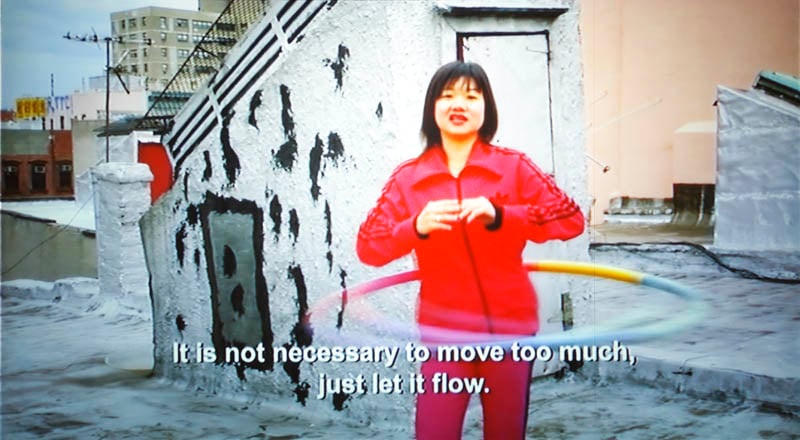
© » KADIST
Christian Jankowski
In New York City’s Chinatown, subject Suat Ling Chua’s morning exercise is to practice the hula hoop. When Christian Jankowski first saw this woman he immediately got the idea to shoot Rooftop Routine . In the short video, Chua leads the group and dictates the movements that each participant has to repeat.

© » KADIST
Ayoung Kim
In 2019, Ayoung Kim traveled to Mongolia to research its widespread animistic belief system towards land, mother rock, stones, and sacred caves that purify human guilt. The Mongolian people’s belief that rocks and minerals are alive, like other natural elements, consider the particular origin myth that human beings were born from stones. For the video work Petrogenesis, Petra Genetrix Kim creates her own hyperbolic mythology connected to the origin of the fictional mineral genderless Petra Genetrix, a figure who also appears in other recent works by the artist.

© » KADIST
Sung Tieu
Modelled and rendered in 3D, Moving Target Shadow Detection by Sung Tieu reconstructs the entire interior of the Hotel Nacional de Cuba in Havana, the site of the first-known instance of a supposed sonic attack, which collectively became known as ‘Havana Syndrome’. First reported by CIA staff in the Cuban capital in 2016, the syndrome includes a range of unexplained disorders ranging from nausea, fatigue and memory loss to brain injuries resembling concussions. In Tieu’s film, CCTV camera footage and images taken by a nano drone lead from the hotel’s lobby to an occupied hotel room, where the viewer is confronted with classified documents and news reportages of the recent Havana Syndrome attacks around the world.
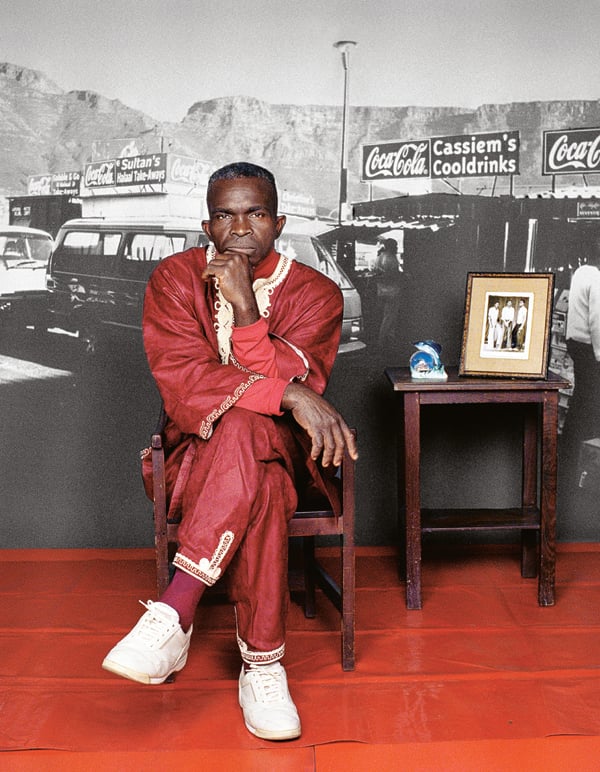
© » KADIST
Sue Williamson
In her 2003 series “Better Lives”, Sue Williamson explores stories of immigrants in search of a better life in a historically contentious South Africa. In an attempt to address and confront xenophobia in South African history, Better Lives series subverts racism and prejudice by emphasizing the immigrant as human, and thus gives the subjects a voice. “Better Lives: Richard Belalufu” tells a tale of surviving in a hostile South Africa through the undercurrent reflections on violence, abuse and the difficulty of finding home as an immigrant.

© » KADIST
Mithu Sen
wombmate! by Mithu Sen is part of a project called AºVOID. In this fragmented mental map, the landscape is fleeting, embossed, and ethereal; there are moments of recognition and also a near-violent sudden emptying of memory.

© » KADIST
Hu Yun
This research-based artwork acts as a memorial to early twentieth century European exploration of China. An antique open suitcase reveals a pile of rubbings and an air-dried peony, while projected photographs of the Chinese landscape appear as a slideshow on the gallery wall. The artifacts refer to a 1908-1909 expedition of naturalists, missionaries, and colonists to the west of China, which ended abruptly with the death of one of the travelers by unusual circumstances.

© » KADIST
Mithu Sen
home, a temporary place by Mithu Sen is part of a project called AºVOID. In this fragmented mental map, the landscape is fleeting, embossed, and ethereal; there are moments of recognition and also a near-violent sudden emptying of memory. Bodies are skeletal, nature is in entropy, context is removed.
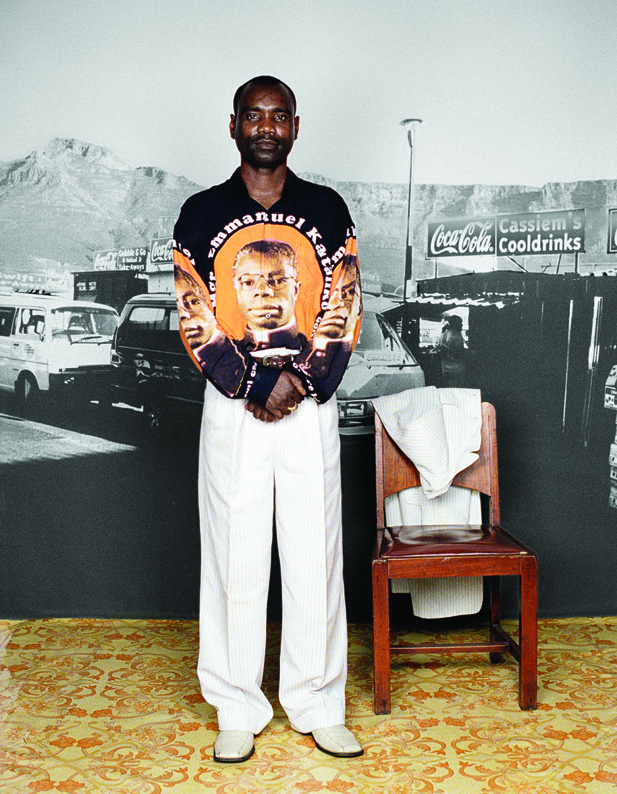
© » KADIST
Sue Williamson
In her 2003 series “Better Lives”, Sue Williamson explores stories of immigrants in search of a better life in a historically contentious South Africa. In an attempt to address and confront xenophobia in South African history, Better Lives series subverts racism and prejudice by emphasizing the immigrant as human, and thus gives the subjects a voice. “Better Lives: Richard Belalufu” tells a tale of surviving in a hostile South Africa through the undercurrent reflections on violence, abuse and the difficulty of finding home as an immigrant.

© » KADIST
Gala Porras-Kim
Drawing & Print (Drawing & Print)
The graphite drawing 4 mourners on a mantel by Gala Porras-Kim is part of a larger installation and body of research, entitled An Index and Its Settings (Un Índice y Sus Entornos) , in which the artist reconsiders 235 ancient burial figures (from circa 200 BCE – 50 CE) from what is now Mexico’s Pacific coast that are part of the Proctor Stafford Collection held by the Los Angeles County Museum of Art (LACMA). Eschewing their current musicological function, 4 mourners on a mantel presents photo-realistic depictions of said figures on top of a hypothetical collector’s fireplace. Herein, these funerary objects are displaced as curios which stare back at the viewer in signs of grief and confusion.
Lim Sokchanlina
Lim Sokchanlina, nicknamed ‘Lina’, works across documentary and conceptual practices with photography, video, installation, and performance; particularly drawn to the use and function of space where urban communities meet rural attitudes...
siren eun young jung
With a practice deeply engaged with feminism and LGBT rights issues, siren eun young jung reveals the subversive power of traditional culture, one unknown in the Korean modernization period, and provides unique perspectives and documentation of important communities...
Sung Hwan Kim
In his practice, Sung Hwan Kim assumes the role of director, editor, performer, composer, narrator, and poet...
Angela Su
Angela Su’s practice is derived from her two divergent backgrounds–she received a degree in biochemistry in Canada before pursuing visual arts...
Christine Sun Kim
- location: New York, New York
- year born: 1980
- gender: female
- nationality: American
- home town: Orange County, California
Charles Lim
Charles Lim Yi Yong’s work encompasses film, installation, sound, recorded conversations, text, drawing, and photography...
Sun Xun
- location: Hangzhou, China
- year born: 1980
- gender: male
- nationality: Chinese
- home town: Fuxin, Liaoning Provence, China
Minouk Lim
- location: Seoul, South Korea
- year born: 1968
- gender: female
- nationality: Korean
Sin Wai Kin
Through performance, moving image, writing, and print, artist Sin Wai Kin (formerly known as Victoria Sin) uses speculative fiction to interrupt normative processes of desire, identification, and objectification...
Mithu Sen
Mithu Sen’s writing is central to her practice, as a poet from West Bengal, a region of great Indian literary history, poetic and visual tropes giving ground to her challenge of semiotics...
Sue Williamson
Sue Williamson (b...
Heecheon Kim
Kim Heecheon’s complex video installations are deeply rooted in his experiences, opening possibilities for a dual visual discourse that combines personal feelings, informed by his immediate surroundings, in a digitized global environment...
Sung Tieu
Sung Tieu’s artistic vocabulary explores the vast and evolving protection and control industries, still rooted in the logic of the Cold War, used to restrict and mould subjects in subsequently globalized capitalism...
Kiluanji Kia Henda
A self-taught artist, Kiluanji Kia Henda employs a strong sense of humour in his work, which often hones in on themes of identity, politics, and perceptions of post-colonialism and modernism in Africa...
Chris Huen Sin-Kan
Chris Huen Sin-Kan (b...
Christine Rebet
Taking formal cues from the optical illusions and landscapes drawn in pre-cinematic entertainment, French artist Christine Rebet seeks to unveil the way these kinds of devices are mirrored in contemporary politics and media...
Wong Kit Yi
Wong Kit Yi’s conceptual and performance-based work animates human interactions by measuring, locating, and quantifying the intangible...
Sylbee Kim
Sylbee Kim’s video installations reflect economic uncertainty and ecological urgencies through digital and physical compositions...
Ayoung Kim
Ayoung Kim is interested in notions of crossings, transmissions, transnationals, trans-positions and reversibility...
Lee Kit
Born in 1978 in Hong Kong Lives and works in Taipei, Taiwan Lee Kit represented the Honk Kong pavilion at the Venice Biennale in 2013 where the exhibition was turned into a half functional private space...
Christiane Baumgartner
Christiane Baumgartner’s practice is related to her origins...
Christian Salablanca
Costa Rican artist Christian Salablanca Díaz has developed a body of work around the phenomenon and experience of violence and the ways in which it generates, determines, and conditions history, society, and politics...
H.H. Lim (Hooi Hwa)
H...
Christine Sun Kim and Thomas Mader
Christine Sun Kim and Thomas Mader have been collaborating for the last 5 years, covering communication in a variety of formats such as recording an overnight shipment from Berlin to New York ( Recording Contract , 2013), compiling 24 hours of invited contributors’ studio time ( Busy Day , 2014), and using the arm game, a combination of body and face, in order to describe a series awkward situations ( Classified Digits , 2016)....
Jun Nguyen-Hatsushiba
- location: Vietnam
- year born: 1968
- gender: male
- nationality: Japanese-Vietnamese
- home town: Tokyo, Japan
Christina Quarles
Christina Quarles’ work is concerned with the female body...
Gala Porras-Kim
Gala Porras-Kim’s work plays objects against their framing to consider how an artefact’s “message” is tempered by display, use, historic setting, and other modes of exchange...
Hu Yun
- location: Shanghai, China
- year born: 1986
- gender: male
- nationality: Chinese
- home town: Shanghai, China
Tsang Kin-Wah
- location: Hong Kong, China
- year born: 1976
- gender: male
- nationality: Chinese
- home town: Shantou, Guangdong Province, China
-
2000-2009
Sue Williamson
2003In her 2003 series “Better Lives”, Sue Williamson explores stories of immigrants in search of a better life in a historically contentious South Africa...
Sue Williamson
2003In her 2003 series “Better Lives”, Sue Williamson explores stories of immigrants in search of a better life in a historically contentious South Africa...
Jun Nguyen-Hatsushiba
2003Filmed underwater, this is the third video in Nguyen-Hatsushiba’s “Memorial Project” series which began in 2001...
H.H. Lim (Hooi Hwa)
2004Images is a two channel video work addressing the relationship between art and ritual...
Christiane Baumgartner
Drawing & Print
2006(Drawing & Print) Baumgartner’s own excursion into war imagery is the diptych Formation ...
Sung Hwan Kim
2007An early work in Sung Hwang Kim’s career, the video Summer Days in Keijo—written in 1937 is a fictional documentary, the film is based on a non-fiction travelogue, In Korean Wilds and Villages , written by Swedish zoologist Sten Bergman, who lived in Korea from 1935 to 1937...
Sung Hwan Kim
Drawing & Print
2007(Drawing & Print) Sung Hwan Kim created the drawing push against the air 01 during a rehearsal for his eponymous 2007 performance at De Apple (as part of Prix de Rome), Amsterdam, and Project Arts Centre, Dublin...
Christian Jankowski
2008In New York City’s Chinatown, subject Suat Ling Chua’s morning exercise is to practice the hula hoop...
-
2010-2019
Sung Hwan Kim
Drawing & Print
2010(Drawing & Print) This untitled drawing was part of Sung Hwan Kim’s solo exhibition Sung Hwan Kim: A Still Window From Two or More Places , which took place in tranzitdisplay in Prague, Czech Republic in 2010...
Sung Hwan Kim
Drawing & Print
2010(Drawing & Print) This untitled drawing was part of Sung Hwan Kim’s solo exhibition Sung Hwan Kim: A Still Window From Two or More Places , which took place in tranzitdisplay in Prague, Czech Republic in 2010...
Angela Su
Drawing & Print
2011(Drawing & Print) From afar, Chimeric Antibodies by Angela Su may look like scientific drawings or botanical illustrations...
Kiluanji Kia Henda
2011Redefining The Power (with Didi Fernandes) is a metaphor of how reflections on history and society during the Angolan Civil War (1975-2002) are largely ignored within the canon of history...
Tun Win Aung and Wah Nu
2011Tun Win Aung and Wah Nu initiated the series 1000 Pieces (of White) in 2009, as a way to produce objects and images as a portrait of their shared life as partners and collaborators...
Minouk Lim
2012The Possibility of the Half by Minouk Lim is a two-channel video projection that begins with a mirror image of a weeping woman kneeling on the ground...
siren eun young jung
2013Deferral Archive is one of the archival extensions of siren eun young jung’s Yeoseong Gukgeuk Project (2008-), a decade-long ethnographic research project into the diminishing genre of Korean traditional theater known as Yeoseong Gukgeuk ...
siren eun young jung
2013Lyrics 1, 2, 3 is part of siren eun young jung Yeoseong Gukgeuk Project (2008–)...
Chris Huen Sin-Kan
2013Contrast to the bustling and unrelenting experience of a city such as Hong Kong, Chris Huen Sin Kan paints the tranquil interiors of his apartment, where he leads a modest and almost hermit-like life...
Charles Lim
2014In SEA STATE 6 Charles Lim takes the viewer down the Jurong Rock Caverns in Singapore, a massive underground infrastructure for oil and fuel storage, built to support the commercial operations of oil traders, petrochemical ventures and manufacturing industries in the area...
Charles Lim
2014In SEA STATE 6 Charles Lim takes the viewer down the Jurong Rock Caverns in Singapore, a massive underground infrastructure for oil and fuel storage, built to support the commercial operations of oil traders, petrochemical ventures and manufacturing industries in the area...
Christine Rebet
2015In the Soldier’s Head evokes the traumas of war through the prism of the hallucinations of a soldier...
Heecheon Kim
2015Lifting Barbells is a video by Kim Heecheon that narrates his letters in Spanish to his girlfriend in Argentina, discussing his feelings after his father died in a bicycling accident...
siren eun young jung
Drawing & Print
2015(Drawing & Print) Deferral Archive is one of the archival extensions of siren eun young jung’s Yeoseong Gukgeuk Project (2008-), a decade-long ethnographic research project into the diminishing genre of Korean traditional theater known as Yeoseong Gukgeuk ...
siren eun young jung
2015Deferral Archive is one of the archival extensions of siren eun young jung’s Yeoseong Gukgeuk Project (2008-), a decade-long ethnographic research project into the diminishing genre of Korean traditional theater known as Yeoseong Gukgeuk ...
Christine Sun Kim and Thomas Mader
2016Indexes that either allow or inhibit the establishment of communication exist in both signed as well as spoken languages...
Sin Wai Kin
Drawing & Print
2017(Drawing & Print) A woman you thought you knew by Sin Wai Kin originates from a performance series titled A View from Elsewhere ...
Gala Porras-Kim
Drawing & Print
2017(Drawing & Print) The graphite drawing 4 mourners on a mantel by Gala Porras-Kim is part of a larger installation and body of research, entitled An Index and Its Settings (Un Índice y Sus Entornos) , in which the artist reconsiders 235 ancient burial figures (from circa 200 BCE – 50 CE) from what is now Mexico’s Pacific coast that are part of the Proctor Stafford Collection held by the Los Angeles County Museum of Art (LACMA)...
Lim Sokchanlina
2017The photographic series Wrapped Future II by Lim Sokchanlina brings fences used on construction sites to enclose the surrounding areas, to different locations, lakes, valleys and forests; and places them at the center of works to obscure the beautiful Cambodian landscape...
Lim Sokchanlina
2017The photographic series Wrapped Future II by Lim Sokchanlina brings fences used on construction sites to enclose the surrounding areas, to different locations, lakes, valleys and forests; and places them at the center of works to obscure the beautiful Cambodian landscape...
Lim Sokchanlina
2017The photographic series Wrapped Future II by Lim Sokchanlina brings fences used on construction sites to enclose the surrounding areas, to different locations, lakes, valleys and forests; and places them at the center of works to obscure the beautiful Cambodian landscape...
Lim Sokchanlina
2017The photographic series Wrapped Future II by Lim Sokchanlina brings fences used on construction sites to enclose the surrounding areas, to different locations, lakes, valleys and forests; and places them at the center of works to obscure the beautiful Cambodian landscape...
Wong Kit Yi
2017Artist Wong Kit Yi’s A River in the Freezer combines directed and found footage to meditate upon glacial memory, cryogenics, and frozen fiction...
Sin Wai Kin
2018The video Tell me everything you saw, and what you think it means by Sin Wai Kin is from a performance series titled A View from Elsewhere...
Christina Quarles
2018The title of the painting refers to the fact that the figure’s behind is raised upwards and the face is found at the bottom of the painting, thus inverting the way in which people are normally seen...
Christian Nyampeta
2018The film Sometimes It Was Beautiful by Christian Nyampeta poetically addresses the systemic conditions leading and emerging from the 1994 Rwandan genocide, which had lasting and profound effects on Rwanda and neighbouring countries like Congo...
Lim Sokchanlina
2018The photographic series Wrapped Future II by Lim Sokchanlina brings fences used on construction sites to enclose the surrounding areas, to different locations, lakes, valleys and forests; and places them at the center of works to obscure the beautiful Cambodian landscape...
Lim Sokchanlina
2018The photographic series Wrapped Future II by Lim Sokchanlina brings fences used on construction sites to enclose the surrounding areas, to different locations, lakes, valleys and forests; and places them at the center of works to obscure the beautiful Cambodian landscape...
siren eun young jung
2018Taking the same name as their most recent solo show at the Kunstverein für die Rheinlande und Westfalen in Düsseldorf, siren eun young jung’s video work Deferral Theatre intertwines various threads from the last decade of the artist’s research into the Yeoseong Gukgeuk theatrical form, in which all of the roles are played by women, as well as performance-based modes of queer resistance in South Korea...
siren eun young jung
Drawing & Print
2018(Drawing & Print) Deferral Archive is one of the archival extensions of siren eun young jung’s Yeoseong Gukgeuk Project (2008-), a decade-long ethnographic research project into the diminishing genre of Korean traditional theater known as Yeoseong Gukgeuk ...
Lim Sokchanlina
2018The photographic series Wrapped Future II by Lim Sokchanlina brings fences used on construction sites to enclose the surrounding areas, to different locations, lakes, valleys and forests; and places them at the center of works to obscure the beautiful Cambodian landscape...
Lim Sokchanlina
2018The photographic series Wrapped Future II by Lim Sokchanlina brings fences used on construction sites to enclose the surrounding areas, to different locations, lakes, valleys and forests; and places them at the center of works to obscure the beautiful Cambodian landscape...
Lim Sokchanlina
2018The photographic series Wrapped Future II by Lim Sokchanlina brings fences used on construction sites to enclose the surrounding areas, to different locations, lakes, valleys and forests; and places them at the center of works to obscure the beautiful Cambodian landscape...
Yim Sui Fong
2019In the nine-channel video installation, Against Step by Yim Sui Fong, a phantasmagorical image of a male dancer appears on a large-scale video projected on a floating retro-projection screen...
Ayoung Kim
2019In 2019, Ayoung Kim traveled to Mongolia to research its widespread animistic belief system towards land, mother rock, stones, and sacred caves that purify human guilt...
Angela Su
2019Produced in an interview format and as an extended chapter of Cosmic Call (2019) in the KADIST Collection, Angela Su’s True Calling by Angela Su documents the artist’s answers to a series of questions on the conception of her 2019 film that proposes speculative cosmic synchronicities for an alternative understanding of epidemics that is not built on the foundation and authority of Western medical science...
Angela Su
Drawing & Print
2019(Drawing & Print) In the first part of Cosmic Call by Angela Su the voiceover proposes in a neutral, documentary-like tone, a series of stories to rethink the way we usually understand, justify, or place blame for epidemiological events...
-
2020-2029
Christian Salablanca
2021Hueso de culebra (Snake Bone) arises from the stories that the artist’s grandmother used to tell him as a child about her father’s medical and spiritual practices in the southern part of Costa Rica, close to the border with Panama...
Sylbee Kim
2021Sylbee Kim’s Unindebted Life is a single-channel video, commissioned and premiered at the 13th Gwangju Biennale (2021)...
Christine Sun Kim
2022Hand Palm Echo 1 is a digital animation based on Christine Sun Kim’s staircase mural at The Drawing Center in New York (10 March – 22 May, 2022)...












